Optimization of Solar Panels in Urban Environments:ACase Study of Louisville
Chloe BarnesGeography Senior Seminar
Professor Ted Schatzki
23August 2024
Abstract
This research paper will emphasize the importance of solar power and renewable energy in general, and there will be discussion about the growing popularity of solar panels and the social impact of rising popularity in renewable energy sources. Louisville will be used as a case study to test out the recommended solar panel angles and orientations to see exactly what buildings in the city could best optimize solar panel installations. With the increasing emphasis on renewable energy sources, the optimization of solar panel placement in urban environments has emerged as a crucial area of research.
The study employs a multidisciplinary approach, integrating principles from urban planning, environmental studies, and social sciences. Utilizing geographical information systems (GIS) mapping tools and verified data download resources, we analyze various factors affecting solar energy harvesting potential in Louisville. Building orientation, shadowing effects from surrounding structures, and prevailing weather patterns are quantitatively assessed to identify optimal placement strategies.
In addition to physical factors, social considerations are integrated into the optimization process. Factors such as visual impact on communities, financial options, and community acceptance are examined. The study aims to develop placement strategies that are both technically efficient and socially acceptable. The findings of this research contribute to the advancement of sustainable urban development by providing practical insights for policymakers, urban planners, and energy practitioners. By optimizing solar panel placement, cities like Louisville can maximize their renewable energy potential, reduce greenhouse gas emissions, and foster community engagement in the transition towards a greener future.
Introduction
The increasing global emphasis on mitigating climate change and transitioning towards sustainable energy sources has led to a growing interest in harnessing solar energy in urban environments.As cities expand and populations grow, the demand for electricity rises, making it imperative to explore efficient and effective ways to integrate solar power generation into urban landscapes. One key aspect of this endeavor is the optimization of solar panel placement, ensuring maximum energy harvesting and efficiency while navigating the complexities of urban settings.
In this context, the city of Louisville serves as a compelling case study. Louisville was chosen for this case study example because it is a relatively large city, yet the number of tall buildings is lower in comparison to other cities such as Cincinnati, Indianapolis, or Chicago. Situated in the heart of the United States, Louisville exemplifies the challenges and opportunities inherent in urban solar deployment. With its diverse built environment, varying weather patterns, and evolving socio-economic dynamics, Louisville presents a microcosm of the broader urban energy landscape.
The significance of this research lies in its potential to inform policy, planning, and practice in sustainable urban development. By identifying optimal strategies for solar panel placement, we aim to contribute to the realization of resilient, low-carbon cities that prioritize clean energy and community well-being.
In the following sections, we will explore the theoretical framework underpinning our study, review relevant literature, delineate our methodology, present findings, and discuss implications.
Through this comprehensive examination, we endeavor to shed light on the intricate interplay between technology, environment, and society in the pursuit of a more sustainable urban future.
Literature Review
This research topic is essentially going to delve into the world of solar energy, its benefits, who it would benefit, and the economic, environmental, and social impacts/factors regarding solar panels becoming more popular. The sources gathered are relevant to this research because the credibility of the authors is high, and the topics of each source are going to directly relate to the main topic. I will be able to take information from my sources and gather general data from each one to then make a more generalized claim regarding my overall topic.
Angles and orientation/ Design
These following resources are categorized as a template for how to know exactly what roof angles and building orientation is best for overall energy efficiency: What is the best angle, and orientation for solar panels, Solar panel direction: What is the best angle, Using GIS based methods and lidar data to estimate rooftop solar technical potential in US cities. These resources will help to directly influence my GIS map creation, and it will help take in quantitative data.
Social issues
These two resources can be used for the portion of relation to societal issues and the impact of solar energy’s increasing popularity: The dark side of solar power, AI solar sentiment: The social impacts of solar energy, and The 2024 community power scorecard.
Installation guides
The resources listed here are to help to better understand the rules and guidelines as well as tips on solar panel installation whether it is on private homes or industrial/commercial buildings: How to install solar panels, What is the best angle and orientation for solar panels, and Installing Solar in Louisville These guides to the best possible installation will help people or groups of people be able to decipher what exact placement they might need for their building and it can help break down overall cost and decipher between long-term savings versus the larger first overall payment.
GIS Data/Research
The resources listed here offer examples of detailed scientific research done to better understand the science behind the installations of solar panels and where best to optimize them: Using GIS based-methods and lidar data to estimate rooftop solar technical potential in US cities, and an article by IRENAtitled Renewable energy benefits: Understanding the socioeconomics
Kentucky Solar
The resources listed here are to better understand the specifics of solar power within the state of Kentucky: What do changes to Kentucky’s net metering law mean for solar customers, and Why Kentucky is dead last for wind and solar production. These articles provide context to better understand the quality of renewable energy systems in Kentucky specifically.
Interviews
For these sources, I found through a professor and a fellow classmate of mine. I was able to interview Shaun Lavin, a leader in the Energy Club at the University of Kentucky. I also was granted access to an already completed interview through the Louie B. Nunn Oral History library on UK’s campus. Both interviews allowed me to begin my research because they are both experts in the field of solar power.
Some possible gaps and further research areas might be how to detect weather patterns and climate change and research on how to navigate the research for how to install solar panels in a way to best achieve long-term good performance for best optimal energy efficiency.Another thing to further research could be to look more in depth at how solar panels may impact the environment and if it harbors any health impacts such as habitat fragmentation, land use change, and potential exposure to toxic materials during manufacturing and disposal. So, a gap could potentially be that even though solar panels can provide long-term energy for buildings, there is no say how long they may hold up depending on different climates. So potentially, their resilience could be further researched, and more advanced technologies could be tested for future different designs to harvest even more energy from the sun.
Research Methods
This research paper is going to analyze already published information and then present it on a map created usingArcGIS Pro. The information will be discussed as well as how the social impacts of solar power are becoming heightened, as well as renewable energies becoming more
popular in general. I will be researching scholarly articles that discuss roof angles and building orientations to best install solar power panels.
Research Question
This paper aims to address the fundamental research question: How can the placement of solar panels be optimized in urban environments like Louisville to maximize energy harvesting and efficiency? To tackle this question comprehensively, we delve into a multidimensional analysis that considers a range of factors, including building orientation, shadowing effects, weather patterns, spatial constraints, and social factors.
Overview
The overall issue is to better understand how best to optimize solar panel placement for maximum energy harvesting/efficiency in urban environments. In this research paper, the benefits of solar power are discussed, as well as what types of buildings/surfaces offer the best outcome for solar power installation. Reasons why solar power is worth it will also be described, and that the up-front cost will actually be beneficial over time, whether it be installed on a personal home with an angled roof, or a commercial business building with a flat-top roof.
Map – Louisville Buildings Suitable for Solar Panel Installation
This map was created to help visualize the buildings in Louisville that can be considered suitable for solar panel installation. This map does not take into account the roof health or tree shade of
each building. Instead, it considers the appropriate building height, building orientation, roof angle, and potential topography shading based on elevation levels and hill shade map layers and was created using ArcGIS Pro software.
Posted below is a URL that is public to everyone where these two maps can be viewed closer so it may be easier to read. This page includes concise explanations of both maps as well
Public URL: https://chloevbarnes.github.io/Louisville-Solar-Exposure/
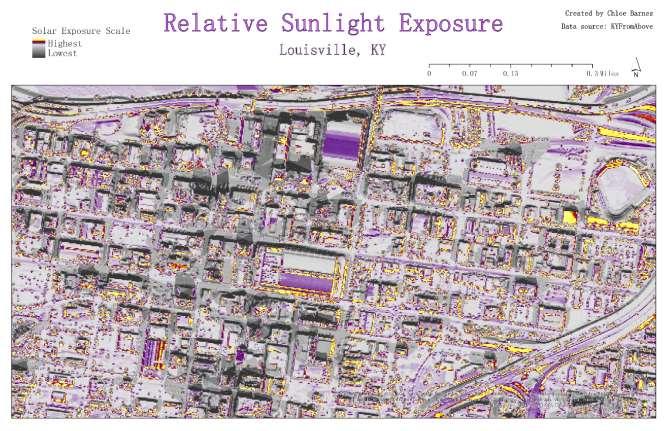
Map 1: Relative Solar Exposure throughout the day in the City of Louisville.
This map was created throughArcGIS Pro, and the data used was from KYFromAbove from 2023 as well as KY NAIP aerial imagery from 2022. I ran coding cells to create multiple layers, five different tires throughout the day. Each tier represented a different time in the day, and the sun was to be calculated at a different angle on the map for each tier.After those five cells were
run, another one was run and calculated the average spots with the most solar exposure out of all five, so it was the average out of all. I could then symbolize the data and say that the bright yellow highlighted spots show most sunlight exposure throughout an average day for a 24-hour time span. It is noticeable that a lot of flat spots on the map are grayed out and that is because the sun is never straight up in the sky, so structures with angled roofs, specifically south-facing angled roofs, received the most overall sunlight exposure. These findings directly correlate with facts later discussed in the paper. One gap I found through the creation of this map and could perhaps be further worked on, is that I had not yet removed trees from the map itself, and trees definitely take into account for shading in areas, even when in urban places.
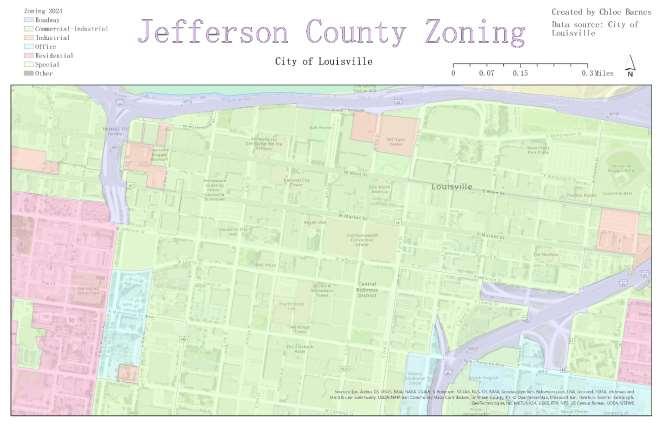
This map was created to act as a reference to the other map, and it gives more clear context as to where exactly specific buildings are in the snapshot, as well as which streets are where, and the zoning layer is to help understand what types of development or land use are located where as well.
Solar Power in Louisville
The city of Louisville seems to be making a good attempt at making solar panel installation easy for residents in the area. The local government has created a website available for residents with access to see who their building inspector is and electric inspector in their area based on their home location (City of Louisville, 2024).
This is a first easy step to getting all the information one would need to be able to make sure someone’s home is capable of installation of this electric system, and there is also access to the official Louisville Land Development Code (LDC) stating that the installation of solar panels on new or existing buildings is shown in section 4.3.16 of this document (City of Louisville, 2024).
The city includes a checklist on their public website for residents to go through in their own time to make sure they have completed all permitting requirements.Along with these things, they also include a solar installer guide with numerous resources and tips, and this is essential for people to see how the process works in simple terms and each step is laid out in front of them to make it easy to comprehend. This could potentially help with making people more willing to try this out instead of sticking to the typical energy system. Additionally, it offers resources for residents interested in installing solar panels, including information about tax credits, financing options, and finding qualified installers. The website aims to support and encourage the adoption of solar
energy in Louisville to promote sustainability and reduce reliance on fossil fuels. The goal is to spread information about the importance of sustainability initiatives within the city of Louisville (City of Louisville, 2024).
Solar Power in Kentucky
The article titled Why Kentucky is Dead Last for Wind and Solar Production written by James Bruggers and Dan Gearino, outlines the history behind the energy transition and how Kentucky is known for the coal industry. This signifies the importance that urban areas in Kentucky are beginning to transition towards cleaner energies in hopes to become more sustainable (Bruggers et al., 2023). In 2022, Kentucky coal production had fallen by 65 percent and its ranking fell to fifth, but even so, the state had also made no investment in wind and solar power, so it remained at the bottom. Kentucky has some catching up to do however, since states such as “Illinois, Indiana, North Dakota, Ohio and Texas all had increases in electricity generation from wind and solar of at least 150 percent in 2022” (Bruggers et al., 2023). Kentucky has tied at the bottom with several other states regarding wind and solar development, but as of recent, we can see that the state is now making an advancement and tackling the energy transition.Andy McDonald, founder and director ofApogee, a firm in Frankfort Kentucky that provides technical assistance and policy research towards advancing a
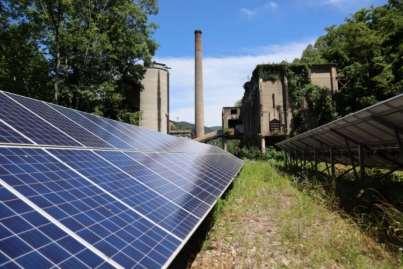
renewable energy transition, stated that “the coal the industry [in Kentucky] has had such a grip on the legislature and the governorship, and the culture, it’s really held back policies that would have supported renewables… it’s not the lack of sunshine” (Bruggers et al., 2023). This is a powerful quote which proves that the legislature in a given place is the leading deciding factor on whether renewable energies become more prominent. However, the legislature will be directly impacted by social impacts, because once people gain more positive awareness, and the idea and conversation surrounding the topic becomes less “politicized”, people would begin to notice that renewable energy is a good thing.
Data Review / Findings
BUILDING ORIENTATION:
AuthorsAshlyn Brooks and Lowe Saddler wrote in their article titled What is the best angle and orientation for solar panels, that solar panel orientation is simply which cardinal direction the panel is facing: north, south, east or west. Typical solar panel application will follow true direction rather than aligning with the magnetic poles. For example, true north aligns with earth’s true axis rather than aligning with the north pole. Homes that have solar panels facing directly east or west will produce around 20% less energy. The proper solar panel orientation for homes located north of the equator is facing true south. For homes located south of the equator, it will be the opposite , facing true north. This will provide the best orientation to allow the most exposure time to the sun and produce the most amount of electricity (Brooks, 2024). We can infer that this quote emphasizes the distinction between true direction (aligned with Earth’s true axis) and magnetic direction (aligned with the magnetic poles). It also states that to be best
optimized, solar panels should be oriented towards true south for locations that are north of the equator. If the houses are oriented in these directions, they will receive the most direct sunlight exposure throughout each day. This would offer the best opportunity for most overall electricity production.
LATITUDE:
Brooks and Saddler noted that to “find the optimal angle for your solar panels, do a Google search for the latitude of your home address or your zip code. Typically, an ideal angle for your solar panels will be equal or close to the latitude of your home (Brooks, 2024). However, proper solar panel angle will fluctuate over the course of the year “the ideal angle for a solar panel installation is close to or equal to the latitude of your home. This angle is typically between 30 degrees and 45 degrees. Doing so ensures your home will get the maximum average output from your solar power system throughout the year” (Brooks, 2024). Latitude is not a term often thought of in regard to installation of solar panels on roofs, but shown here, the titled angle of one’s solar panel can be measured using the latitude of the exact building location.
SOLAR PANEL ANGLE:
In his article titled Solar panel direction: What is the best angle, Liam McCabe notes that “northfacing panels only make sense on “one out of 1,000 installs.” They spend much less time in the sun than panels that face any other direction and the greater the tilt, the worse the production… south-facing solar panels perform best when they’re tilted between 15 and 40 degrees.
Residential rooftops in the US seem to be mostly tilted between 18 and 34 degrees pretty much ideal. Even if your roof falls outside of the 15 to 40-degree goldilocks zone, solar panels can
often still produce more than enough electricity to be worth the investment” (McCabe, 2023). He also notes that the perfect direction is not always perfectly south (180 degrees) – it can vary by a few degrees to the east or west (McCabe, 2023). Based on this information, we see that if solar panels are south facing, the best angle is to be tilted between 15 and 40 degrees. McCabe states that he believes north facing panels are not as best optimized for overall energy production compared to panels facing other directions/poles. The author discussed how panels facing 180 degrees south have the best optimal efficiency in energy production, and if they’re oriented slightly any other way, the energy production would not be as effective. The author continued by noting that roofs are good for solar because you can always tilt your panels toward the south.A common practice is to mount them at a 15-degree angle enough of a tilt to keep off the debris and get the panels into the sweet spot for production, but not so much that the wind gets behind them and pushes like a sail” (McCabe, 2023).
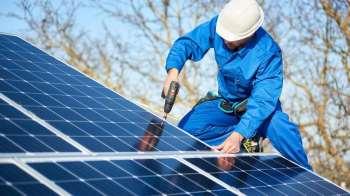
In terms of geographic location, the angle of your panels will increase the further you move from the equator. For context, in states such as Texas and Florida, the sun will stay higher in the sky meaning solar panels in lower states like these will require less tilt (Brooks, 2024). This gives helpful insight to help people that may not live in or near Louisville. It is important to remember everyone will have a unique circumstance with exactly their personal panels would be placed on their roofs.
Authors Brooks and Saddler note that that for summer and the warmer months, it will be 15 degrees minus your latitude. For winter and the cooler months, the ideal solar panel angle will be
15 degrees added to your latitude… during the summer months, the sun will sit higher in the sky. And in winter, the sun will sit lower in the sky. This means that in order to get the most production out of your solar panels you will need to change the tilt with each season… and you’ll want to ensure your solar panels are installed at an angle where snow can easily slide off (Brooks, 2024). These are important reminders since weather patterns also impact solar panels, and homeowners need to take the climate where they currently reside into account before going through the process of installation.
PROCESS:
Things to consider before going through the process of installing solar panels on one’s private home roof: roof condition, roof orientation, general shading in the area in the area, current energy use and lastly to consider future usage once the house is run using solar energy power rather than using energy sourced from fossil fuels (Heynen et al., 2022).
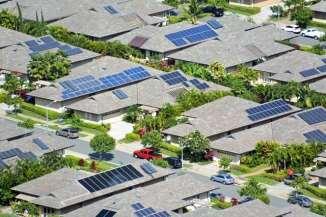
Design and cost quote, contracting, engineering plans, permits (contacting local municipality for approval), installation, inspection, permission to operate (utility inspections to approve and authorize the system), and lastly enjoy and save costs the moment it turns on (Heynen et al., 2022).
According to Biermeier from Forbes, the average working time for installation is 20 hours, but the total time for entire process is about 2 months for paperwork and inspections to be fully completed. There is an average cost of $18,000 for materials and labor. The panels can be
installed at any time of year, but it is important to note what angle would be best based on location, current season, and typical weather conditions in the area (Biermeier, 2024). The information here is a rough estimate from this article, but depending on the size of one’s home and how large the panels will be, and based on location, the average cost and time frame for the entire process will likely vary.
STATISTICS:
In the U.S., home installations of solar panels have fully rebounded from the Covid slump, with analysts predicting more than 19 gigawatts of total capacity installed, compared to 13 gigawatts at the close of 2019. Over the next 10 years, that number may quadruple, according to industry research data.And that’s not even taking into consideration the further impact of possible new regulations and incentives launched by the green-friendly Biden administration” (Atasu et al., 2021).According to this data, there has been a significant rise in renewable energy systems since the COVID era and during lockdown. The Biden administration has also prioritized sustainable initiatives regarding greener energy.
Each year, the Institute for Local Self-Reliance tracks and scores states based on their energy policies and how these policies help or hinder local clean energy action. In the 2024 Community Power Scorecard, out of the total of 50 states and D.C., only one state scraped an above average grade (a B), 11 hit the C average, 13 received Ds, and 6 states received a failing F grade (McCoy, 2024).
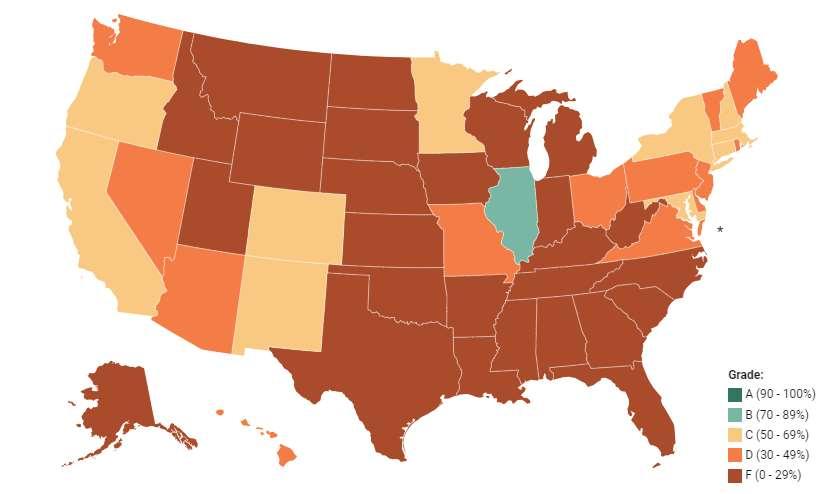
The community power scorecard evaluates how state policies advance energy democracy and allow communities to choose their own paths (McCoy, 2024). This graphic shows that Illinois was the only state in 2024 to receive a high grading in regard to efforts to pursue local clean energy action. This shows that other states in this nation should begin to prioritize action.
Several researchers got together to estimate the technical potential of rooftop solar photovoltaics (PV) for select US cities by combining light detection and ranging (lidar) data, a validated analytical method for determining rooftop PV suitability employing geographic information systems, and modeling of PV electricity generation. We find that rooftop PV's ability to meet estimated city electricity consumption varies widely from meeting 16% of annual consumption
(in Washington, DC) to meeting 88% (in Mission Viejo, CA). Important drivers include average rooftop suitability, household footprint/per-capita roof space, the quality of the solar resource, and the city's estimated electricity consumption (Margolis et al., 2017).
Throughout their research, some major steps included gathering input Lidar data from the US Department of Homeland Security (DHS) for the time frame of 2006-2014. They used this data from across the U.S. to signify building footprints in all 128 cities included in the data. The researchers also created a simulation of PV productivity on suitable rooftop areas for every ZIP code in the lidar data set (Margolis et al., 2017). Their goal was to effectively design a template model for most remewable energy projects.
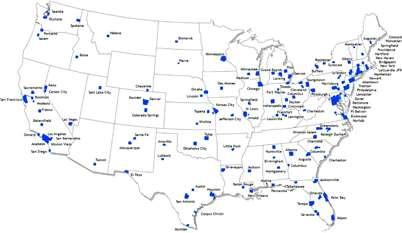
Social Impacts of Solar Energy
It is essential to understand and address community sentiment is paramount as solar energy continues to gain prominence in the quest for sustainability and clean energy sources. Communities' concerns regarding ecological impacts, development noise, solar farm fires, and land infringement are genuine and require careful consideration. As these communities continue to voice their concerns over solar power plant risks, energy policy will continue to be created as a mitigation effort for the social impacts of renewable energy projects (Team, 2023) There is a
sense of importance for community engagement, recognition of community concerns, the role for energy policy, and the continues adaptation of renewable energies.
There is potential for a growth in renewable energy jobs in this country if it is to continue to grow in popularity. This figure shows the general renewable energy employment worldwide in selected countries as of 2016 (IRENA, 2017)
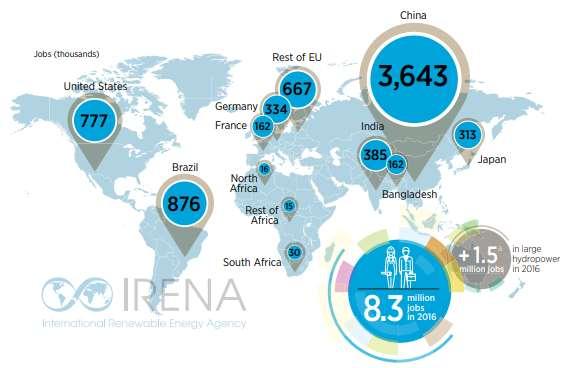
As we can see from the graphic, China, Brazil and the U.S. were leading employers at the time in the renewable energy sector. There has been a considerable shift towards Asian countries, whose share of global renewable energy employment rose from 50% in 2013 to 62% in 2016 (IRENA, 2017). Notably, China is the leader worldwide, offering around 3.6 million renewable energy jobs. Since then, the numbers most certainly have increased.
Interviews
ALEX SMITH:
The first interview involvedAlex Smith, who was interviewed by UK Professor Lauren Cagle from the UK Louie B. Nunn Center for Oral History Library at the University of Kentucky. From this interview, one could infer that there is a current utility bill issue in Kentucky, and that there is a big influence of the Kentucky solar industry.
Upon further research on this issue, the utility bill in Kentucky is in regard to the ongoing debate and policy issues regarding the relationship between solar power and utility bills. One of the major issues involves the topic of net metering, which is essentially when solar panel owners sell excess electricity they generate back to the grid and receive credit on their utility bills. So, the growth of solar panels has raised these operations and it has caused issues since Kentucky has a very traditional model of selling electricity to customer to maintain infrastructure and evenly distributing power. The issue is that solar panel owners are benefiting from the system, but the argument is that they are not paying for their fair share for the use of the grid system. Essentially, solar panel owners rely on the grid infrastructure for backup power, but they pay less for the services since they generate their own electricity (Lane, 1969).
He describes net metering and lobbying in Kentucky as a word that explains the policy for how independent energy producers, particularly solar producers, get paid or credited for their solar consumption or production that they don’t consume. He talked about his major frustrations with working in the solar industry, and how many companies claim they prioritize it, but they really do not. He had to go through multiple jobs until he felt content with the work he was completing.
His hope was to make a difference in regard to installing more renewable energy systems to help battle the issue of climate change.
Another topic he discusses is how we have a long way to go in terms of sustainability. It was expressed during this interview that many of his clients wanted an easy solution in conversations in climate change, yet he realized that is not necessarily possible, especially through solar energy. It is a grim conversation to have, and it was mentioned how unpopular it is to be talked about since it is hard to see any positives in it.
He talked often about “climate grief” and the power it has over people. Conversations about individual versus structural change, and he emphasized that structural change is more likely to make more change. This is because individual change is numerically not enough to change climate change in and of itself. Structural change is then resistant to change, since there are a lot of other factors that go into this topic. He also defines “climate conversations” as a group of concerned citizens who hold space for conversation about climate change and the feelings surrounding it without any rush to solve climate change.
SHAUN LAVIN:The second interview involved Shaun Lavin, who is a leader of the Energy Club at the University of Kentucky, and he has done some research into small-scale solar installations on UK’s campus. He was able to answer my questions and gave some of his input onto the topic. He prefaces that all his thoughts are solely opinions on the topic, and not factually based. He explains all about the basics of solar panels, such as how most solar panels are fixed on a roof, but there are also standalone sun-tracking options.As for building orientation, south facing solar panels typically capture measurements for optimum efficiency, therefore receiving the most sunlight to produce
the most power. He mentions how it is his opinion that single residence solar panel installations are not as effective as larger scale utility installations.
There is discussion about how he believes that many people may be opposed to solar energy because of the large amount of land it consumes. One of the possible solutions is to install them on rooftops, and this can be one great way to mitigate this concern.An issue this that solution though, is that many single-family homeowners would need to replace their roofs in order to install solar panels. This shows that a lot of thought has to go into solar panel placement since it is a big-time commitment as well as a large up-front cost. This is proof that solar power installations should be more focused on utility buildings or large commercial buildings. To build off of his thoughts, another option could be newly designed homes in subdivisions or apartment buildings that could infiltrate solar panel energy into their building design, so the roofs are initially built for solar panels.
Ethical issues
As listed above, it is evident that social factors can come into play for this topic easily. People all have different opinions when it comes to renewable energies installed, specifically, solar power. It comes across as something easy to deal with, but it crosses a boundary in terms of societal norms, and a lot of people will voice their opinion against clean energy. A lot of people dislike change, and switching from typical energy sources to this is a big change, and until it becomes more normalized in society, not a lot of people are very open to it even though it has no real serious negative outcome.
Conclusion
In conclusion, this research paper has explored the multifaceted considerations surrounding the optimization of solar panel placement in urban environments, with a specific focus on the city of Louisville for certain aspects and the creation of a map Through a multidisciplinary approach integrating principles from urban planning, environmental studies, and social sciences, we have delved into the technical, environmental, and social dimensions of solar energy deployment. The findings of this research contribute to the advancement of sustainable urban development by providing practical insights for policymakers, urban planners, and energy practitioners. By maximizing solar panel placement efficiency, cities like Louisville can harness their renewable energy potential, reduce greenhouse gas emissions, and foster community engagement in the transition towards a greener future.
Furthermore, the paper has highlighted the growing importance of solar energy in mitigating climate change and transitioning towards sustainable energy sources. Despite challenges such as policy barriers and societal resistance, the increasing adoption of solar power presents significant opportunities for economic growth, job creation, and environmental preservation.
Moving forward, continued research and action are needed to address remaining gaps and challenges, including the development of advanced technologies for solar panel installation, the mitigation of social and ethical concerns, and the promotion of inclusive and equitable access to solar energy resources. By working collaboratively across disciplines and sectors, we can realize the full potential of solar energy and accelerate the transition towards a more sustainable and resilient urban future.
Bibliography
Atasu, A., Duran, S., & Van Wassenhove, L. N. (2021, June 18). The dark side of solar power. Harvard Business Review. https://hbr.org/2021/06/the-dark-side-of-solarpower?utm_medium=paidsearch&utm_source=google&utm_campaign=domcontent_business mgmt&utm_term=Non-
Brand&tpcc=domcontent_businessmgmt&gad_source=1&gclid=CjwKCAiA8YyuBhBSEiwA 5R3-E1lIKgWmxEKItI7lVj1ydgloIX2H7iu7f60e84Ki-EjpW4TP4AxCEhoCkMQQAvD_BwE
Biermeier, D. (2024, March 15). How to install solar panels. Forbes. https://www.forbes.com/home-improvement/solar/how-to-install-solar-panels/
Brooks, A. (2024, March 19). What is the best angle and orientation for solar panels?. Forbes.
https://www.forbes.com/home-improvement/solar/best-angle-for-solarpanels/#:~:text=For%20most%20homeowners%2C%20the%20ideal,power%20system%20thro ughout%20the%20year
Bruggers, J., Gearino, D. (2023, March 31). Why Kentucky is dead last for wind and solar production. Inside Climate News. https://insideclimatenews.org/news/31032023/kentuckycoal-wind-solar/ City of Louisville. (2024). Installing Solar in Louisville
https://louisvilleky.gov/government/sustainability/installing-solar-louisville IRENA. (2017). Renewable energy benefits: Understanding the socio-economics
https://www.irena.org/-
/media/Files/IRENA/Agency/Publication/2017/Nov/IRENA_Understanding_Socio_Economics
_2017.pdf?la=en&hash=C430B7EF772BA0E631190A75F7243B992211F102
Lane, C. (1969, November 1). What do changes to Kentucky’s net metering law mean for solar customers? Compare solar companies, solar panels, and solar prices. https://www.solarreviews.com/blog/kentucky-net-metering-changes-to-affect-solar-customers
Lavin, S. (2024, February 26). Interview
Margolis, R., Gagnon, P., Melius, J., Phillips, C., & Elmore, R. (2017, July 6). 8) Using GIS basedmethods and lidar data to estimate rooftop solar technical potential in US cities
Environmental Research Letters. https://iopscience.iop.org/article/10.1088/1748-9326/aa7225
McCoy, M. (2024, March 20). The 2024 community power scorecard. Institute for Local SelfReliance. https://ilsr.org/2024-community-power-scorecard/
McCabe, L. (2023, November 6). Solar panel direction: What is the best angle?. EnergySage. https://www.energysage.com/solar/solar-panel-performance-orientation-angle/
Smith, A. (2023, July 14). Interview with Lauren E. Cagle. https://kentuckyoralhistory.org/ark:/16417/xt7v959wj91pv
Team, T. (2023, September 23). AI solar sentiment: The social impacts of Solar Energy https://www.transect.com/blog/ai-solarsentiment#:~:text=Solar%20projects%20often%20require%20large,or%20threatens%20cultura l%20heritage%20sites
